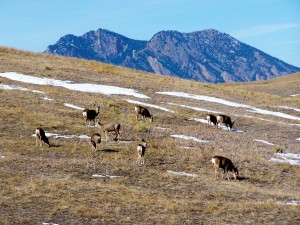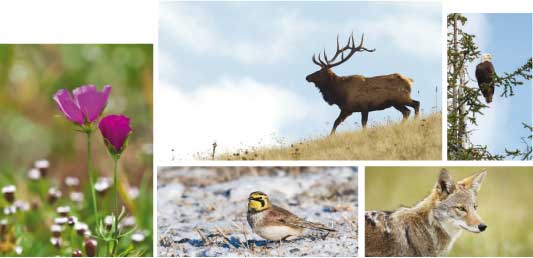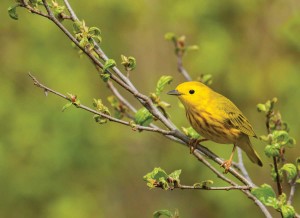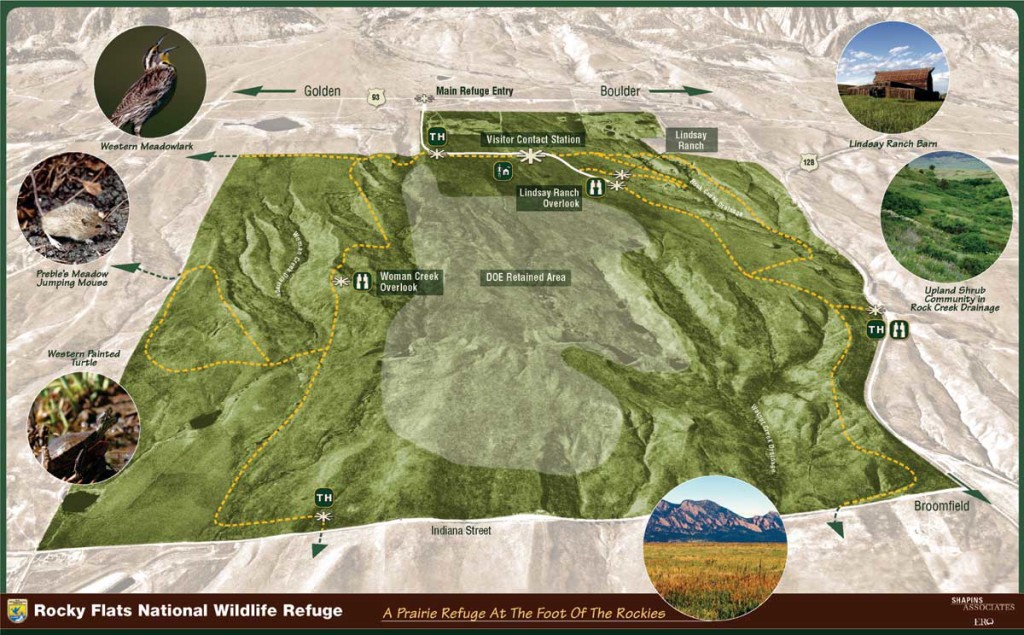Rocky Flats National Wildlife Refuge
26 Sep 2015
Despite its heritage, the Rocky Flats National Wildlife Refuge is a diverse treasure of wildlife and plants.
By Tanya Ishikawa Claude Vallieres says he didn’t see any two-headed skunks or deformed deer on a recent guided tour of Rocky Flats National Wildlife Refuge. But what he did see astounded him. “I was awed,” Vallieres says. “You hear so many negatives about how it’s contaminated and polluted, yet I saw twenty-plus elk and deer, a bald eagle, a prairie falcon and lots of other birds.” In fact, the newly opened refuge, a short drive from Boulder on Highway 93, is an oasis for native plants and animals. Once a border between a controversial nuclear-weapon-parts manufacturing plant and public lands, the area that is now the Rocky Flats National Wildlife Refuge is bursting with ecological diversity.
“It’s a unique gem along the Front Range,” says David Lucas, refuge supervisor for Rocky Flats as well as the Rocky Mountain Arsenal and Two Ponds National Wildlife Refuge. The refuge’s habitat developed over thousands of years and remains relatively untouched, he says. It’s home to elk, grassland birds and the federally threatened Preble’s meadow jumping mouse, as well as the occasional black bear and mountain lion passing through.
Birds sighted at the refuge include red-tailed hawks, northern harriers, peregrine falcons, western meadowlarks, killdeers, great horned owls, yellow warblers, burrowing owls, and red-winged and yellow-headed blackbirds. Other animals seen there are mule and whitetail deer, black-tailed jackrabbits, black-tailed prairie dogs, Western painted turtles, chorus frogs and prairie rattlesnakes.
Vallieres, an avid birder who took a two-hour tour of the refuge in July, also glimpsed many species of butterflies and wildflowers, and prairie grasses that have fallen to development elsewhere. “There’s so much diversity,” he says. “The cattails, lots of different wildflowers and the grasslands. If you like nature and the outdoors, it’s a great place to explore.”
The habitat has been preserved largely because it’s protected from development and was the security buffer for the former Rocky Flats Environmental Technology Site, a facility that produced plutonium triggers for nuclear warheads beginning in the early 1950s. The plant closed in 1989, when the Department of Energy (DOE) acquired the site and oversaw the cleanup of radiation contamination until 2005.
Under the Rocky Flats National Wildlife Refuge Act, passed by Congress in 2001, about 5,000 acres became a refuge in 2007 under stewardship of the U.S. Fish and Wildlife Service. The DOE retains jurisdiction over the 600-acre former weapons site and monitoring areas, which will never be open to the public.
Because the refuge site has been off-limits to the public for decades, it’s a rich source of biodiversity. “Surrounding landscapes have been changed by agriculture and urban development, but many of these buffer areas have become large islands of relatively undisturbed biotic communities,” notes Jody Nelson, the refuge’s senior ecologist, in a 2010 research paper.
In fact, the newly opened refuge, a short drive from Boulder on Highway 93, is an oasis for native plants and animals. Once a border between a controversial nuclear-weapon-parts manufacturing plant and public lands, the area that is now the Rocky Flats National Wildlife Refuge is bursting with ecological diversity.
“It’s a unique gem along the Front Range,” says David Lucas, refuge supervisor for Rocky Flats as well as the Rocky Mountain Arsenal and Two Ponds National Wildlife Refuge. The refuge’s habitat developed over thousands of years and remains relatively untouched, he says. It’s home to elk, grassland birds and the federally threatened Preble’s meadow jumping mouse, as well as the occasional black bear and mountain lion passing through.
Birds sighted at the refuge include red-tailed hawks, northern harriers, peregrine falcons, western meadowlarks, killdeers, great horned owls, yellow warblers, burrowing owls, and red-winged and yellow-headed blackbirds. Other animals seen there are mule and whitetail deer, black-tailed jackrabbits, black-tailed prairie dogs, Western painted turtles, chorus frogs and prairie rattlesnakes.
Vallieres, an avid birder who took a two-hour tour of the refuge in July, also glimpsed many species of butterflies and wildflowers, and prairie grasses that have fallen to development elsewhere. “There’s so much diversity,” he says. “The cattails, lots of different wildflowers and the grasslands. If you like nature and the outdoors, it’s a great place to explore.”
The habitat has been preserved largely because it’s protected from development and was the security buffer for the former Rocky Flats Environmental Technology Site, a facility that produced plutonium triggers for nuclear warheads beginning in the early 1950s. The plant closed in 1989, when the Department of Energy (DOE) acquired the site and oversaw the cleanup of radiation contamination until 2005.
Under the Rocky Flats National Wildlife Refuge Act, passed by Congress in 2001, about 5,000 acres became a refuge in 2007 under stewardship of the U.S. Fish and Wildlife Service. The DOE retains jurisdiction over the 600-acre former weapons site and monitoring areas, which will never be open to the public.
Because the refuge site has been off-limits to the public for decades, it’s a rich source of biodiversity. “Surrounding landscapes have been changed by agriculture and urban development, but many of these buffer areas have become large islands of relatively undisturbed biotic communities,” notes Jody Nelson, the refuge’s senior ecologist, in a 2010 research paper.
 The xeric tallgrass and mixed-grass prairie dominating the landscape, in combination with grasses on Boulder County Open Space to the west, is believed to be the largest remaining North American tract of this type of prairie plant community, covering approximately 1,811 acres, Nelson says. Other plant communities there include needle and thread grass prairie, Great Plains riparian woodland, and willow and wild indigo shrublands, tall upland shrubland, wetlands and reclaimed grasslands.
In fact, diversity is the “most impressive” aspect of this 10-square-mile refuge, Nelson states. “To date, approximately 638 species of plants (including seven species considered rare or imperiled by the Colorado Natural Heritage Program) have been documented at the site.” The refuge is in a transitional zone between two communities—the Rocky Mountains and the Great Plains. “As a result, we have species from both of these areas, which increases the diversity,” Nelson says.
“It’s one of the most beautiful scenic places you would ever want to see in your life,” says Arthur “Murph” Widdowfield, board president of the Rocky Flats Institute and Museum. “From the hills, you can look down on Denver, look over Arvada and Westminster and see the foothills to the west. The wildflowers are gorgeous, the grass is gorgeous; it’s absolutely beautiful.”
The xeric tallgrass and mixed-grass prairie dominating the landscape, in combination with grasses on Boulder County Open Space to the west, is believed to be the largest remaining North American tract of this type of prairie plant community, covering approximately 1,811 acres, Nelson says. Other plant communities there include needle and thread grass prairie, Great Plains riparian woodland, and willow and wild indigo shrublands, tall upland shrubland, wetlands and reclaimed grasslands.
In fact, diversity is the “most impressive” aspect of this 10-square-mile refuge, Nelson states. “To date, approximately 638 species of plants (including seven species considered rare or imperiled by the Colorado Natural Heritage Program) have been documented at the site.” The refuge is in a transitional zone between two communities—the Rocky Mountains and the Great Plains. “As a result, we have species from both of these areas, which increases the diversity,” Nelson says.
“It’s one of the most beautiful scenic places you would ever want to see in your life,” says Arthur “Murph” Widdowfield, board president of the Rocky Flats Institute and Museum. “From the hills, you can look down on Denver, look over Arvada and Westminster and see the foothills to the west. The wildflowers are gorgeous, the grass is gorgeous; it’s absolutely beautiful.”
Open for Business
Though environmental activists have raised concerns over health risks at Rocky Flats, Widdowfield believes the refuge is free of contamination. “I would let my kids or grandkids go hiking down there with no problem at all,” he says. The land was “nothing more than a security boundary to begin with, strictly a buffer zone to keep the weapons plant secure,” he explains. “The radiation levels there now are less than the natural background radiation levels. All of the eastern slope of the Rockies has natural uranium, and those background levels are greater than even the DOE site.” Since the cleanup, the government continues to monitor water at the site for contamination and remediation. Air monitoring was stopped, Widdowfield says, because no air contamination had been found in five years.
“We rely on the EPA and public health agencies on the issues of worker and public safety,” says refuge supervisor Lucas, of the U.S. Fish and Wildlife Service. “I’ve looked at all the data and these buffer areas are safe. Those folks have spent tens of thousands of hours monitoring it.”
While cleanup and monitoring activities received federal funding, Lucas says his agency received no funds to manage the refuge and has sought grants and other funding sources. “It’s difficult for us to open the refuge until we have basic infrastructure to support public visitation. We were making a bit of progress, but the September 2013 flood really set us back,” he says.
In comparison, the 15,000-acre refuge at the Rocky Mountain Arsenal, about 20 miles away in Commerce City, opened much more quickly. With the cleanup of its former chemical-weapons storage completed in 2010, five years after the Rocky Flats cleanup, the arsenal is one of the country’s largest and most active urban refuges, with bison and an estimated 330 other animal species.
While the arsenal will be the main site for public environmental education, “Rocky Flats will be more of an open-space model where wildlife protection is the main activity,” he says, noting the rocky, hilly terrain makes it a challenging site for trail development.
“It’s very rocky terrain, for sure,” Vallieres says. “The trails were not trails, but dirt service roads and a road to the Lindsay cattle ranch. The old ranch buildings are still there. It’s a neat place.”
Since the cleanup, the government continues to monitor water at the site for contamination and remediation. Air monitoring was stopped, Widdowfield says, because no air contamination had been found in five years.
“We rely on the EPA and public health agencies on the issues of worker and public safety,” says refuge supervisor Lucas, of the U.S. Fish and Wildlife Service. “I’ve looked at all the data and these buffer areas are safe. Those folks have spent tens of thousands of hours monitoring it.”
While cleanup and monitoring activities received federal funding, Lucas says his agency received no funds to manage the refuge and has sought grants and other funding sources. “It’s difficult for us to open the refuge until we have basic infrastructure to support public visitation. We were making a bit of progress, but the September 2013 flood really set us back,” he says.
In comparison, the 15,000-acre refuge at the Rocky Mountain Arsenal, about 20 miles away in Commerce City, opened much more quickly. With the cleanup of its former chemical-weapons storage completed in 2010, five years after the Rocky Flats cleanup, the arsenal is one of the country’s largest and most active urban refuges, with bison and an estimated 330 other animal species.
While the arsenal will be the main site for public environmental education, “Rocky Flats will be more of an open-space model where wildlife protection is the main activity,” he says, noting the rocky, hilly terrain makes it a challenging site for trail development.
“It’s very rocky terrain, for sure,” Vallieres says. “The trails were not trails, but dirt service roads and a road to the Lindsay cattle ranch. The old ranch buildings are still there. It’s a neat place.”
 The 2005 refuge plan envisioned 10 to 20 miles of public trail creation in the future. This summer, the first guided hikes were offered several times at the refuge.
For the rest of the year and into 2016, the site will host similar small tours in suitable weather, but no winter activities until facilities are built, Lucas says. The USFWS and DOE are collaborating to construct a small visitors center with interpretive displays and items from the Rocky Flats Museum. The center could be open by the end of 2016 or early 2017. The USFWS has also agreed to post signage describing the site’s history, contamination, cleanup and restricted-access rules.
However, the refuge’s main purpose is to be “the one place where wildlife truly comes first,” Lucas says. In addition to habitat preservation, the refuge and its partners will collect seeds of native plants to restore lands throughout the Front Range, and eradicate invasive plants in targeted areas.
“The threat to conservation is huge,” Lucas says. “But the biggest threat is our changing society. Kids are mostly growing up in metro areas now, and have lost their connection to the land. We’ve come to realize that we have to connect kids to nature and wildlife. We have 560 refuges across the country, mostly in rural environments, and we’re fortunate to have a handful of urban spots like Rocky Flats, so we can show why conservation is so important close to home.”
Vallieres thought the tour was informative and enriching. “I definitely learned more about the area,” he says. “Not only the vegetation and wildlife, but also the history and geology.”
“What should we do? Just leave it barren [because of the weapons plant]?” he asks. “Some people will be upset that it’s opening to the public, but why not?”
The 2005 refuge plan envisioned 10 to 20 miles of public trail creation in the future. This summer, the first guided hikes were offered several times at the refuge.
For the rest of the year and into 2016, the site will host similar small tours in suitable weather, but no winter activities until facilities are built, Lucas says. The USFWS and DOE are collaborating to construct a small visitors center with interpretive displays and items from the Rocky Flats Museum. The center could be open by the end of 2016 or early 2017. The USFWS has also agreed to post signage describing the site’s history, contamination, cleanup and restricted-access rules.
However, the refuge’s main purpose is to be “the one place where wildlife truly comes first,” Lucas says. In addition to habitat preservation, the refuge and its partners will collect seeds of native plants to restore lands throughout the Front Range, and eradicate invasive plants in targeted areas.
“The threat to conservation is huge,” Lucas says. “But the biggest threat is our changing society. Kids are mostly growing up in metro areas now, and have lost their connection to the land. We’ve come to realize that we have to connect kids to nature and wildlife. We have 560 refuges across the country, mostly in rural environments, and we’re fortunate to have a handful of urban spots like Rocky Flats, so we can show why conservation is so important close to home.”
Vallieres thought the tour was informative and enriching. “I definitely learned more about the area,” he says. “Not only the vegetation and wildlife, but also the history and geology.”
“What should we do? Just leave it barren [because of the weapons plant]?” he asks. “Some people will be upset that it’s opening to the public, but why not?” 











